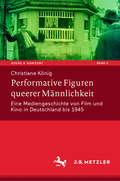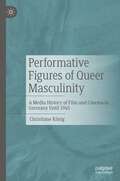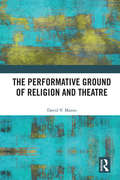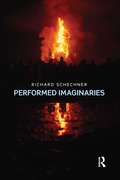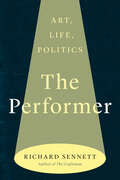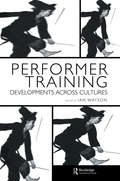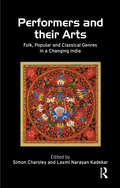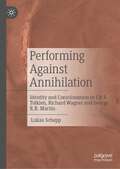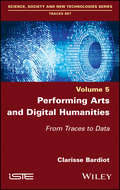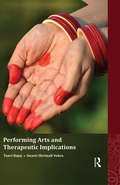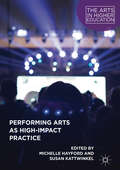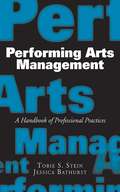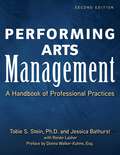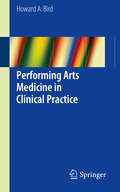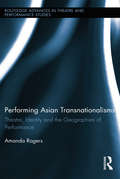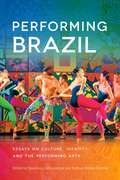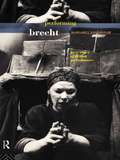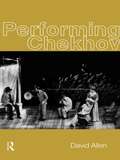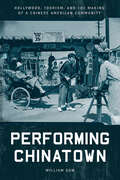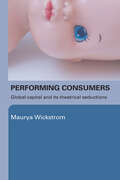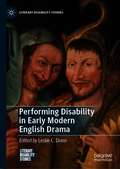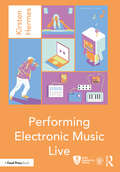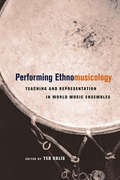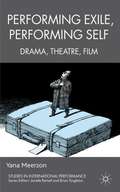- Table View
- List View
Performative Figuren queerer Männlichkeit: Eine Mediengeschichte von Film und Kino in Deutschland bis 1945 (Szene & Horizont. Theaterwissenschaftliche Studien #5)
by Christiane KönigDie medienkulturgeschichtliche Arbeit ist eine deutsche Kino- und Filmgeschichte von den 1890er Jahren bis 1945 mit Fokus auf queere Männlichkeit. Mit medienwissenschaftlichen Ansätzen zeigt die Studie, wie sich das ‚neue Medium’ Film durch performative Wiederaufführungen spektakulärer Elemente aus den Unterhaltungs- und Wissenskulturen des 19. Jahrhunderts konstituiert. Darin werden Körper, Begehren und Identitäten durch Differenzbildungen ständig remodelliert. Männliche Queerness bedeutet hier folglich nicht Repräsentation männlicher Homosexualität. Vielmehr ist sie dynamisches Ergebnis komplexer medialer Prozesse, in Verknüpfung mit Affekten und (Selbst-)Erkenntnissen auf und vor der Leinwand. Aufbauend auf dem queer-feministischen Konzept der queer performativity von Eve K. Sedgwick, erstellt die Autorin ein historisch situiertes Modell, mit dem sie verschiedene Figuren technisch-anthropomorpher queerer Männlichkeit des Mediums Film im ermächtigenden Sinne nachzeichnet. Die anhand von einzelnen Langfilmen herauspräparierten Figuren sind dabei stets mitbedingt durch Veränderungen der assemblage des Kino-Apparats über die Jahrzehnte bis 1945 sowie durch zeitgenössisch aktuelle Aspekte der Geschlechtergeschichte und der Geschichte der Sexualität in Deutschland.
Performative Figures of Queer Masculinity: A Media History of Film and Cinema in Germany Until 1945
by Christiane KönigThis is a German history of cinema and film from the 1890s to 1945 with a focus on queer masculinity. Using media studies approaches, the study shows how film as a new medium is constituted through performative re-enactments of spectacular elements from the entertainment and knowledge cultures of the 19th century. In it, bodies, desires and identities are constantly remodelled through the formation of difference. Therefore, male queerness here does not mean the representation of male homosexuality. Rather, it is the dynamic result of complex medial processes, affects and (self-)knowledge on and off the screen. Building on Eve K. Sedgwick's queer-feminist concept of queer performativity, the author creates a historically situated model with which she traces various figures of technically anthropomorphic queer masculinity in the medium of film in an empowering sense. This book is a translation of an original German 1st edition Performative Figuren queerer Männlichkeit by Christiane König, published by J.B.Metzler, imprint of Springer-Verlag GmbH Germany, part of Springer Nature in 2020. The translation was done with the help of artificial intelligence (machine translation by the service DeepL.com). The author (with the friendly support of Megan Hanson) has subsequently revised the text further in an endeavour to refine the work stylistically. Springer Nature works continuously to further the development of tools for the production of books and on the related technologies to support authors.
The Performative Ground of Religion and Theatre
by David V. MasonReligious practitioners and theatregoers have much in common. So much, in fact, that we can say that religion is often a theatrical phenomenon, and that theatre can be a religious experience. By examining the phenomenology of religion, we can in turn develop a better understanding of the phenomenology of theatre. That is to say, religion can show us the ways in which theatre is not fake. This study explores the overlap of religion and theatre, especially in the crucial area of experience and personal identity. Reconsidering ideas from ancient Greece, premodern India, modern Europe, and the recent century, it argues that religious adherents and theatre audiences are largely, themselves, the mechanisms of their experiences. By examining the development of the philosophy of theatre alongside theories of religious action, this book shows how we need to adjust our views of both. Featuring attention to influential notions from Plato and Aristotle, from the Natyashastra, from Schleiermacher to Sartre, Bourdieu, and Butler, and considering contemporary theories of performance and ritual, this is vital reading for any scholar in religious studies, theatre and performance studies, theology, or philosophy.
Performed Imaginaries
by Richard SchechnerIn this collection of essays, performance studies scholar and artist Richard Schechner brings his unique perspective to bear upon some of the key themes of society in the 21st century. Schechner connects the avantgarde and terror, the counter-cultural movement of the 1960s/70s and the Occupy movement; self-wounding art, popular culture, and ritual; the Ramlila cycle play of India and the way imagination structures reality; the corporate world and conservative artists. Schechner asks artists to redeploy Nehru's Third World as a movement not of nations but of like-minded culture workers who must propose counter-performances to war, violence, and the globalized corporate empire. With characteristic brio, Schechner urges us to play for keeps. "Playing deeply is a way of finding and embodying new knowledge", he writes. Performed Imaginaries ranges through some of the key moves within Schechner’s oeuvre, and challenges today’s experimental artists, activists, and scholars to generate a new, third world of performance.
The Performer: Art, Life, Politics
by Richard SennettAn acclaimed sociologist&’s exploration of the connections among performances in life, art, and politics In The Performer, Richard Sennett explores the relations between performing in art (particularly music), politics, and everyday experience. It focuses on the bodily and physical dimensions of performing, rather than on words. Sennett is particularly attuned to the ways in which the rituals of ordinary life are performances. The book draws on history and sociology, and more personally on the author&’s early career as a professional cellist, as well as on his later work as a city planner and social thinker. It traces the evolution of performing spaces in the city; the emergence of actors, musicians, and dancers as independent artists; the inequality between performer and spectator; the uneasy relations between artistic creation and social and religious ritual; the uses and abuses of acting by politicians. The Janus-faced art of performing is both destructive and civilizing.
Performer Training: Developments Across Cultures (Contemporary Theatre Studies #Vol. 38)
by Ian WatsonPerformer Training is an examination of how actors are trained in different cultures. Beginning with studies of mainstream training in countries such as Poland, Australia, Germany, and the United States, subsequent studies survey: · Some of Asia's traditional training methods and recent experiments in performer training · Eugenio Barba's training methods · Jerzy Grotowski's most recent investigations · The Japanese American NOHO companies attempts at integrating Kyogen into the works of Samuel Beckett · Descriptions of the training methods developed by Tadashi Suzuki and Anne Bogart at their Saratoga International Theatre Institute · Recent efforts to re-examine the role and scope of training, like Britain's International Workshop Festival and the European League of Institutes of Arts masterclasses · The reformulation of the use of emotions in performer training known as Alba Emoting.
Performers and Their Arts: Folk, Popular and Classical Genres in a Changing India
by Simon CharsleyIntroduction Part I: Caste, Community and performance A ritual performance of Kerala, Vayala Vasudevan PillaiThe Patuas of Bengal, Makbul IslamBards and goddesses: The Pombalas in Tirupati, Anand AkundyExplorations in the art forms of the Cindu madigas in Andhra, Y A Sudhakar Reddy and R R HarischandraCaste identity and performance in a fisher-village of Assam, Kishore BhattacharjeePart II: Performance Beyond CasteTelugu pady natakam in Andhra: Performance dynamics, P SubbacharyModernising tradition: The yaksagana in Karnataka, Guru Rao BapatKalarippayatt as aesthetics and the politics of invisibility in Kerala, P K SasidharanIndia People’s Theatre Association in colonial Andhra, V RamakrishnaGaddar and the politics and pain of singing, D Venkat RaoReviving moghal tamsa in Orissa, Sachi MohantyPart III: Classical Dance and its SuccessorsNew directions in Indian dance, Sunil KothariTranspositions in kuchipudi dance, Aruna BhikshuThe impact of commercialization in dance, K Subadra MurthyArt addressing social problems, Ananda Shankar Jayant
Performing Against Annihilation: Identity and Consciousness in J.R.R. Tolkien, Richard Wagner and George R.R. Martin
by Lukas ScheppThis book outlines how the protagonists in The Nibelung's Ring, The Lord of the Rings, and Game of Thrones attempt to construct identities and expand their consciousness manifestations. As the characters in the three works face the ends of their respective worlds, they must find answers to their mortality, and to the threat it implies: the loss of identity and consciousness. Moreover, it details how this process is depicted performatively. In a hands-on and interdisciplinary approach, this book seeks to unveil the underlying philosophical concepts of identity and consciousness in the three works as they are represented audio-visually on stage and screen. Through the use of many practical examples, this book offers both academic scholars and any interested readers a completely new perspective on three enduringly popular and interrelated works.
The Performing Artist's Handbook
by Janice PapolosThe right ways to handle all of the nonmusical essentials of your career, the practical know-how you need to progress in your professional music career.
Performing Arts and Digital Humanities: From Traces to Data
by Clarisse BardiotDigital traces, whether digitized (programs, notebooks, drawings, etc.) or born digital (emails, websites, video recordings, etc.), constitute a major challenge for the memory of the ephemeral performing arts.Digital technology transforms traces into data and, in doing so, opens them up to manipulation. This paradigm shift calls for a renewal of methodologies for writing the history of theater today, analyzing works and their creative process, and preserving performances. At the crossroads of performing arts studies, the history, digital humanities, conservation and archiving, these methodologies allow us to take into account what is generally dismissed, namely, digital traces that are considered too complex, too numerous, too fragile, of dubious authenticity, etc.With the analysis of Merce Cunningham’s digital traces as a guideline, and through many other examples, this book is intended for researchers and archivists, as well as artists and cultural institutions.
Performing Arts and Therapeutic Implications
by Tanvi Bajaj Swasti Shrimali VohraPresenting an alternative perspective, this book proposes that performing arts forge an emotional bond between the performer and the audience, making the act of performance a therapeutic and restorative experience, and not merely recreational. Studying the life-experiences of six artists, and their unique engagement with three art forms — music, drama and dance — the book highlights the physical, emotional, mental, and spiritual effects of performing arts both on the performers and the audience. More importantly, it takes the current understanding of the therapeutic role of arts beyond a deficit model of health that focuses on their use in curing illnesses, disabilities and imbalances, towards a more positive growth-centric model that relates them to promoting holistic mental health, well-being and happiness. It thus bridges the gap between the theoretical understanding of creative arts therapy and the practical experience of performing arts in non-therapeutic settings. Further, it assumes increasing relevance with respect to fast-changing lifestyles to which stress and ill-health are often attributed. The book will appeal to artists, educators and researchers of performing arts, applied psychology, counselling and therapy, and cultural studies, as well as interested general readers.
Performing Arts as High-Impact Practice (The\arts In Higher Education Ser.)
by Susan Kattwinkel Michelle HayfordThis book investigates how the performing arts in higher education nationally contribute to the “high impact practices,” as identified by the Association of American Colleges and Universities (AACU). Using the well-known map of the HIPs for illustrating the centrality of performing arts practices in higher education, the editors and authors of this volume call for increased participation by performing arts programs in general education and campus initiatives, with specific case studies as a guide. Performing arts contribute to the efforts of their institution in delivering a strong liberal arts education that uniquely serves students to meet the careers of the future. This is the first book to explicitly link the performing arts to the HIPs, and will result in the implementation of best practices to better meet the educational needs of students. At stake is the viability of performing arts programs to continue to serve students in their pursuit of a liberal arts education.
Performing Arts Management: A Handbook of Professional Practices
by Jessica Bathurst Tobie S. SteinDo you know what it takes to manage a performing arts organization today? In this comprehensive volume, more than 100 managers of top nonprofit and commercial venues share their winning strategies.* Financial management, building a funding base, labor relations, much more* Explores the realities of running a performing arts organization todayFrom theater to classical music, from opera to dance, every type of organization is included, with information on how each one is structured, key managerial figures, its best-practices for financial management, how it handles labor relations, and more. Kennedy Center, the Brooklyn Academy of Music, Lincoln Center, the Mark Morris Dance Company, the New Victory Theater, the Roundabout Theater, the Guthrie Theater, Steppenwolf Theater Company, and many other top groups are represented. Learn to manage a performing arts group successfully in today's rapidly changing cultural environment with Performing Arts Management.
Performing Arts Management (Second Edition): A Handbook of Professional Practices
by Tobie S. Stein Jessica Rae Bathurst Renee LasherDo you know what it takes to manage a performing arts organization today? In this revised second edition of the comprehensive guide, more than 100 managers of top nonprofit and commercial venues share their winning strategies.From theater to classical music, from opera to dance, every type of organization is included, with information on how each one is structured, key managerial figures, its best-practices for financial management, how it handles labor relations, and more.Kennedy Center, the Brooklyn Academy of Music, Lincoln Center, the Mark Morris Dance Company, the New Victory Theater, the Roundabout Theater, the Guthrie Theater, Steppenwolf Theater Company, and many other top groups are represented.Learn to manage a performing arts group successfully in today&’s rapidly changing cultural environment with Performing Arts Management.
Performing Arts Medicine in Clinical Practice
by Howard A. BirdFor many general practitioners, physiotherapists, osteopaths and chiropracters, patients with a background in performing arts account for only a small proportion of their practice. This simple primer assists the reader in the management of these highly complex (and sometimes highly strung) elite athletes. This book is pitched at the Masters level. A first degree in a medical speciality is assumed so space has not been allocated to the standard management of common conditions such as epicondylitis, carpal tunnel syndrome, ankle sprains of fractures. With some thirty years practical experience around the theme of "Controversies in Performing Arts Medicine", the editor has provided occupational rheumatological care for performing artists, especially instrumentalists and dancers with complex ailments. The introductory section provides a basic insight into the musculoskeletal problems specific to each of the many varied instruments and styles of dance. Consideration is also given to musculoskeletal aspects that affect the voice.
Performing Asian Transnationalisms: Theatre, Identity, and the Geographies of Performance (Routledge Advances in Theatre & Performance Studies)
by Amanda RogersThis book makes a significant contribution to interdisciplinary engagements between Theatre Studies and Cultural Geography in its analysis of how theatre articulates transnational geographies of Asian culture and identity. Deploying a geographical approach to transnational culture, Rogers analyses the cross-border relationships that exist within and between Asian American, British East Asian, and South East Asian theatres, investigating the effect of transnationalism on the construction of identity, the development of creative praxis, and the reception of works in different social fields. This book therefore examines how practitioners engage with one another across borders, and details the cross-cultural performances, creative opportunities, and political alliances that result. By viewing ethnic minority theatres as part of global — rather than simply national — cultural fields, Rogers argues that transnational relationships take multiple forms and have varying impetuses that cannot always be equated to diasporic longing for a homeland or as strategically motivated for economic gain. This argument is developed through a series of chapters that examine how different transnational spatialities are produced and re-worked through the practice of theatre making, drawing upon an analysis of rehearsals, performances, festivals, and semi-structured interviews with practitioners. The book extends existing discussions of performance and globalization, particularly through its focus on the multiplicity of transnational spatiality and the networks between English-language Asian theatres. Its analysis of spatially extensive relations also contributes to an emerging body of research on creative geographies by situating theatrical praxis in relation to cross-border flows. Performing Asian Transnationalisms demonstrates how performances reflect and rework conventional transnational geographies in imaginative and innovative ways.
Performing Brazil
by Severino J. Albuquerque Kathryn Bishop-SanchezA field-shaping anthology by top cultural critics and practitioners representing a wide range of disciplines and art forms, Performing Brazil is the first book to bring together studies of the many and varied manifestations of Brazilian performance in and beyond their country of origin. Arguing that diverse forms of performance are best understood when presented in tandem, it offers new takes on better-known forms, such as carnival and capoeira, as well as those studied less often, including gender acts, curatorial practice, political protest, and the performance of Brazil in the United States. The contributors to the volume are Maria José Somerlate Barbosa, Eric A. Galm, Annie McNeill Gibson, Ana Paula Höfling, Benjamin Legg, Bryan McCann, Simone Osthoff, Fernando de Sousa Rocha, Cristina F. Rosa, Alessandra Santos, and Lidia Santos.
Performing Brecht
by Margaret EddershawPerforming Brecht is an unprecedented history of the productions of Brecht's plays in Britain over forty years. Margaret Eddershaw surveys all aspects of Brecht in performance, from his methodologies to his place in postmodernist theatre and beyond.She focuses on key productions by directors including George Devine, Sam Wanamaker, William Gaskill, Howard Davies, John Dexter and Richard Eyre. Eddershaw also provides three in-depth case studies of productions in the 1990s, incorporating her own exclusive access to the rehearsals and in-depth interviews with directors and performers. The case studies are: * The Good Person of Sechuan, directed by Deborah Warner and starring Fiona Shaw; * Mother Courage, directed by Philip Prowse and starring Glenda Jackson; * The Resistable Rise of Arturo Ui, directed by Di Trevis and starring Antony Sher
Performing Chekhov
by David AllenFirst published in 1999. Routledge is an imprint of Taylor & Francis, an informa company.
Performing Chinatown: Hollywood, Tourism, and the Making of a Chinese American Community (Asian America)
by William GowIn 1938, China City opened near downtown Los Angeles. Featuring a recreation of the House of Wang set from MGM's The Good Earth, this new Chinatown employed many of the same Chinese Americans who performed as background extras in the 1937 film. Chinatown and Hollywood represented the two primary sites where Chinese Americans performed racial difference for popular audiences during the Chinese exclusion era. In Performing Chinatown, historian William Gow argues that Chinese Americans in Los Angeles used these performances in Hollywood films and in Chinatown for tourists to shape widely held understandings of race and national belonging during this pivotal chapter in U.S. history. Performing Chinatown conceives of these racial representations as intimately connected to the restrictive immigration laws that limited Chinese entry into the U.S. beginning with the 1875 Page Act and continuing until the passage of the Immigration and Nationality Act of 1965. At the heart of this argument are the voices of everyday people including Chinese American movie extras, street performers, and merchants. Drawing on more than 40 oral history interviews as well as research in more than a dozen archival and family collections, this book retells the long-overlooked history of the ways that Los Angeles Chinatown shaped Hollywood and how Hollywood, in turn, shaped perceptions of Asian American identity.
Performing Consumers: Global Capital and its Theatrical Seductions
by Maurya WickstromPerforming Consumers is an exploration of the way in which brands insinuate themselves into the lives of ordinary people who encounter them at branded superstores. Looking at our performative desire to ‘try on’ otherness, Maurya Wickstrom employs five American brandscapes to serve as case studies: Ralph Lauren; Niketown; American Girl Place; Disney store and The Lion King; and The Forum Shops at Caesar’s Palace in Las Vegas. In this post-product era, each builds for the performer/consumer an intensely pleasurable, somatic experience of merging into the brand and reappearing as the brand, or the brand’s fictional meanings. To understand this embodiment as the way that capital is producing subjectivity as an aspect of itself, Wickstrom casts a wide net, drawing on: the history of capital’s relationship with theatre political developments in the United States recent work in political science, philosophy, and performance studies. An adventurous study of theatrical indeterminancy and material culture, Performing Consumers brilliantly takes corporate culture to task.
Performing Disability in Early Modern English Drama (Literary Disability Studies)
by Leslie C. DunnPerforming Disability in Early Modern English Drama investigates the cultural work done by early modern theatrical performances of disability. Proffering an expansive view of early modern disability in performance, the contributors suggest methodologies for finding and interpreting it in unexpected contexts. The volume also includes essays on disabled actors whose performances are changing the meanings of disability in Shakespeare for present-day audiences. By combining these two areas of scholarship, this text makes a unique intervention in early modern studies and disability studies alike. Ultimately, the volume generates a conversation that locates and theorizes the staging of particular disabilities within their historical and literary contexts while considering continuity and change in the performance of disability between the early modern period and our own.
Performing Electronic Music Live (Audio Engineering Society Presents)
by Kirsten HermesPerforming Electronic Music Live lays out conceptual approaches, tools, and techniques for electronic music performance, from DJing, DAWs, MIDI controllers, traditional instruments, live sound design, hardware setups, custom software and hardware, to live visuals, venue acoustics, and live show promotion. Through case studies and contrasting tutorials by successful artists, Kirsten Hermes explores the many different ways in which you can create memorable experiences on stage. Featuring interviews with highly accomplished musicians and practitioners, readers can also expand on their knowledge with hands-on video tutorials for each chapter via the companion website, performingelectronicmusic.live. Performing Electronic Music Live is an essential, all-encompassing resource for professionals, students of music production courses, and researchers in the field of creative-focused performance technology.
Performing Ethnomusicology: Teaching and Representation in World Music Ensembles
by Ted SolisPerforming Ethnomusicology is the first book to deal exclusively with creating, teaching, and contextualizing academic world music performing ensembles. Considering the formidable theoretical, ethical, and practical issues that confront ethnomusicologists who direct such ensembles, the sixteen essays in this volume discuss problems of public performance and the pragmatics of pedagogy and learning processes. Their perspectives, drawing upon expertise in Caribbean steelband, Indian, Balinese, Javanese, Philippine, Mexican, Central and West African, Japanese, Chinese, Middle Eastern, and Jewish klezmer ensembles, provide a uniquely informed and many-faceted view of this complicated and rapidly changing landscape. The authors examine the creative and pedagogical negotiations involved in intergenerational and intercultural transmission and explore topics such as reflexivity, representation, hegemony, and aesthetically determined interaction. Performing Ethnomusicology affords sophisticated insights into the structuring of ethnomusicologists' careers and methodologies. This book offers an unprecedented rich history and contemporary examination of academic world music performance in the West, especially in the United States. "Performing Ethnomusicology is an important book not only within the field of ethnomusicology itself, but for scholars in all disciplines engaged in aspects of performance--historical musicology, anthropology, folklore, and cultural studies. The individual articles offer a provocative and disparate array of threads and themes, which Solís skillfully weaves together in his introductory essay. A book of great importance and long overdue."--R. Anderson Sutton, author of Calling Back the Spirit Contributors: Gage Averill, Kelly Gross, David Harnish, Mantle Hood, David W. Hughes, Michelle Kisliuk, David Locke, Scott Marcus, Hankus Netsky, Ali Jihad Racy, Anne K. Rasmussen, Ted Solís, Hardja Susilo, Sumarsam, Ricardo D. Trimillos, Roger Vetter, J. Lawrence Witzleben
Performing Exile, Performing Self
by Yana MeerzonThis book examines the life and art of those contemporary artists who by force or by choice find themselves on other shores. It argues that the exilic challenge enables the #65533;migr#65533; artist to (re)establish new artistic devices, new laws and a new language of communication in both his everyday life and his artistic work.
